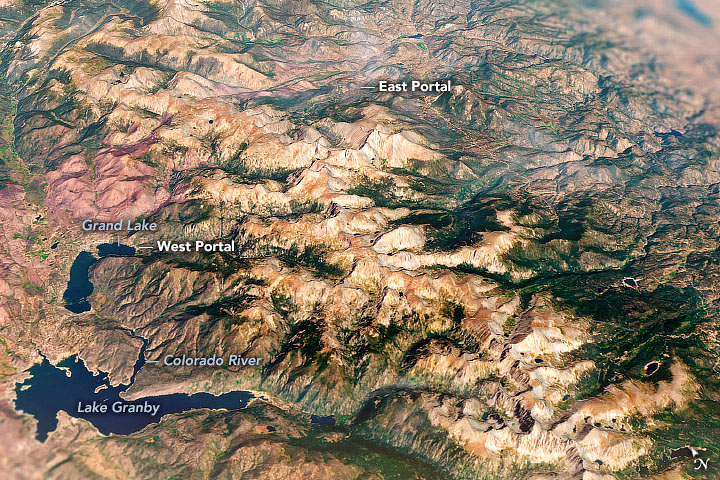
A River Routed Under the Mountains
Downloads
- rockymountain_oli_2021250_lrg.jpg (1716x1020, JPEG)
- rockymountain_oli_2021250_wide_lrg.jpg (5288x4907, JPEG)
Metadata
- Sensor(s):
- Space Shuttle - SRTM
- Landsat 8 - OLI
- Data Date: September 2, 2021
- Visualization Date: June 8, 2022
The rugged, steep Rocky Mountains rise abruptly in the middle of Colorado, splitting the state roughly in half between the western high country and the eastern plains. The extreme contrast of these landscapes also brings an extreme disparity in water.
The Western Slope receives 80 percent of the state’s precipitation, as weather systems rising to cross the continental divide shed their loads of rain and snow before moving east. Water that falls to the west of the divide drains toward the Pacific Ocean, while water that falls to the east runs toward the Gulf of Mexico and Atlantic.
The plains of eastern Colorado, however, are semi-arid. In 1820, explorer Stephen Harriman Long—for whom Long’s Peak is named—famously dismissed it as a “Great Desert” unsuitable for agriculture. But the sandy, loamy soil can make fertile farmland when irrigated.
In the mid- to late-19th century, the Gold Rush and the arrival of the railroad brought an influx of settlers to Colorado, including ranchers and farmers. Then in the 1880s, the plains received higher-than-average precipitation. The new settlers plowed under native drought-resistant grasses and used eastern farming techniques to grow wheat and corn, practices that would later contribute to soil erosion and the Dust Bowl. When drier conditions returned, the residents looked to the Rocky Mountain snowpack and the Colorado River, then known as the Grand River, as a reliable source of water for irrigation. One of the first efforts to tap that supply was the Grand River Ditch. Beginning in 1900, the ditch diverted water from the Never Summer Mountains through Poudre Pass and into the Cache la Poudre River.In the early 1930s, during the Great Depression and the Dust Bowl drought, farmers and their representatives formed the Grand Lake Committee and conceived a more ambitious plan to divert water from the Western Slope of the Rockies and connect the Colorado and Big Thompson rivers. After much negotiation, construction of the Colorado-Big Thompson Project was begun by the U.S. Bureau of Reclamation in 1938. By the time it was completed and declared fully operational in 1957, it comprised 18 dams, 12 reservoirs, six hydroelectric plants, 95 miles (150 kilometers) of canals, and 35 miles (55 kilometers) of tunnels. The most critical of these is the tunnel that runs 13 miles (21 kilometers) under Rocky Mountain National Park and was named for U.S. Senator Alva B. Adams, who championed the project in Congress.
In 1940, two teams of workers began tunneling from either side of Rocky Mountain National Park: one from the West Portal at Grand Lake and one from the East Portal southwest of Estes Park, Colorado. In 1944, when the drilling teams met thousands of feet below the continental divide, the two sides of the tunnel were misaligned by just the width of a penny. The complex task of lining the 9.75-foot (3-meter) diameter tunnel with concrete took a few more years before first water flowed through the tunnel in 1947.
The portals are visible in the image above, which was acquired on September 2, 2021, with the Operational Land Imager (OLI) on Landsat 8 and overlain with topographic data from the Shuttle Radar Topography Mission (SRTM).
Snowmelt and runoff collected in Lake Granby is pumped to a canal that flows into Shadow Mountain Reservoir and Grand Lake, where it enters the West Portal of the Adams tunnel. Upon exiting the East Portal, the water flows into the Wind River toward Mary’s Lake, then proceeds through other tunnels and canals to multiple Front Range reservoirs. Between the West and East portals, the tunnel’s elevation drops 109 feet (33 meters). Driven by the force of gravity, water flows through the tunnel at a rate of 550 cubic feet (15.5 cubic meters) per second—traveling the length of the tunnel in about two hours.
It was a $160 million feat of civil engineering (roughly equivalent to $2 billion in today’s dollars). But it was not achieved without some controversy. Many residents of the Western Slope felt they were not being adequately compensated for the loss of water. Conservationists feared the project would despoil the natural beauty of Rocky Mountain National Park. The project proceeded after officials reached an agreement to construct the Green Mountain dam and reservoir to store water on the Western Slope, and to move the tunnel portals outside the boundaries of the national park.
Today, the Colorado-Big Thompson project delivers 200,000 acre-feet of water a year to northeastern Colorado, quenching the thirst of one million residents and irrigating more than 600,000 acres of farmland. Although the diversion project was initially built to irrigate farms and fields, it now also supplies water for cities and towns, industry, hydropower generation, recreation, and fish and wildlife. In Colorado, where more than 80 percent of the people live where only 20 percent of the precipitation falls, such transbasin water diversions have become a part of life.
References
- Colorado State University Public Lands History Center Grand River Ditch. Accessed June 7, 2022.
- Hurt, R. D. (2016) Colorado’s Great Plains. Colorado Encyclopedia. Accessed June 7, 2022.
- National Park Service Colorado: Green Mountain Powerplant. Accessed June 7, 2022.
- National Park Service Colorado: Estes Powerplant. Accessed June 7, 2022.
- National Park Service (2004) The Colorado-Big Thompson Project. Rocky Mountain NP: Administrative History, Chapter 8. Accessed June 7, 2022.
- Northern Water Adams Tunnel: The Lynchpin to the C-BT Project. Accessed June 7, 2022.
- Northern Water Colorado-Big Thompson Project. Accessed June 7, 2022.
NASA Earth Observatory images by Joshua Stevens, using Landsat data from the U.S. Geological Survey and topographic data from the Shuttle Radar Topography Mission (SRTM). Story by Sara E. Pratt.
This image record originally appeared on the Earth Observatory. Click here to view the full, original record.
